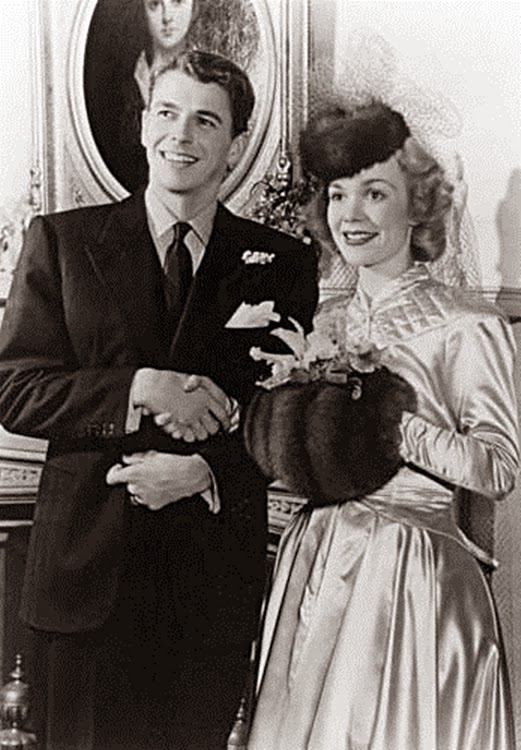 Bernard Dick is a prolific Hollywood biographer (he is the author Forever Mame: The Life of Rosalind Russell; Claudette Colbert: She Walked in Beauty; Hollywood Madonna: Loretta Young). His latest project, The President’s Ladies: Jane Wyman and Nancy Davis takes a unique look Ronald Reagan, a former actor and one of America's most popular presidents, who married not one but two Hollywood actresses. This book is actually three biographies in one and uncovers fascinating connections between Wyman, Reagan, and Davis.
Bernard Dick is a prolific Hollywood biographer (he is the author Forever Mame: The Life of Rosalind Russell; Claudette Colbert: She Walked in Beauty; Hollywood Madonna: Loretta Young). His latest project, The President’s Ladies: Jane Wyman and Nancy Davis takes a unique look Ronald Reagan, a former actor and one of America's most popular presidents, who married not one but two Hollywood actresses. This book is actually three biographies in one and uncovers fascinating connections between Wyman, Reagan, and Davis. Below, Dick talks about his inspiration behind the book and surprising discoveries he made during his research. The President's Ladies is available in April.
What was the inspiration behind
such a unique, three-headed monster of a biography?
I had
originally intended to write a biography of Jane Wyman. I know I must
have seen her earlier than 1948, but that was my coming-of-age year. I
was in the seventh grade when I saw Johnny Belinda, for which she won an Oscar. I was amazed at her ability to play a
hearing and speech impaired woman, who does not speak a single word in the
entire film. I cannot forget how shocked I saw by the rape scene, when
Stephen McNally approaches Jane, whose pleading look indicates that she
knew what will happen and cannot bear the thought of it. Sexual
violence was portrayed by suggestion then, but suggestion can leave a
memory that time cannot erase. I still cannot forget it.
How did that memory morph
into The President's Ladies?
I saw
All About Eve on television, a film
that I knew well and about which I had written. In the
final scene,
when Barbara Bates bows before a three-way mirror, I had an idea. Jane's
life is part of two other lives—she married Ronald Reagan, divorced him, remarried
(not successfully), leaving Reagan to remarry happily to an aspiring actress,
Nancy Davis.
Nancy was the mate for whom he was destined. A competent actress but never a star, she found her place in the pantheon as First Lady. One doubts that there would ever have been a President Reagan, if it were not for Nancy. Both found their best roles at 1600 Pennsylvania Ave. I think of this book as a triptych, with Jane in the center flanked by Reagan and Nancy.
 |
| Ronald and Jane on their wedding day |
Nancy was the mate for whom he was destined. A competent actress but never a star, she found her place in the pantheon as First Lady. One doubts that there would ever have been a President Reagan, if it were not for Nancy. Both found their best roles at 1600 Pennsylvania Ave. I think of this book as a triptych, with Jane in the center flanked by Reagan and Nancy.
Nancy
and Reagan were good actors. Nancy could have been a fine character actress.
She excelled at playing wives, mothers, secretaries, teachers—the staples of TV
sitcoms and series. Reagan had a real flair for romantic comedy. He
could do drama when it was not psychological, failing only once when he went
out of his element to play an epileptic in Night Unto Night.
What was the most
surprising thing you found during your research?
I
knew that Reagan switched parties and became a Republican, but I never knew he
was such a rabid anti-Communist until I started this book. His
anti-Communist paranoia was the main reason for Jane's divorcing him. She
simply could not stand listening to his rants. In Nancy, Reagan found an
audience. She was indeed the mate for whom he was intended.
 However,
my biggest discovery was Jane Wyman's conversion to Catholicism. It began
when she was making Stage Fright in London. One day, the car that was at
her disposal drove past Westminster Cathedral, She asked the driver to stop,
having never seen such an imposing sight before. Later, she had the
courage to enter the Cathedral. Seeing rosaries for sale in a gift shop,
she bought one and another for a friend, thinking they were the equivalent of
admission tickets. She soon learned otherwise.
However,
my biggest discovery was Jane Wyman's conversion to Catholicism. It began
when she was making Stage Fright in London. One day, the car that was at
her disposal drove past Westminster Cathedral, She asked the driver to stop,
having never seen such an imposing sight before. Later, she had the
courage to enter the Cathedral. Seeing rosaries for sale in a gift shop,
she bought one and another for a friend, thinking they were the equivalent of
admission tickets. She soon learned otherwise. Fascinated by Catholicism, she began preparing for her conversion to the Catholic Faith and eventually was received into the Church. From that point on, namely from 1954 to her death, she remained a devout Catholic. In the last years of her life, she became a Third Order Dominican, and was buried in the Dominican habit.
I am
honored to tell her story. She was a woman of great faith, which, in
retrospect, came through in her performances, even before she converted.
She was always looking for something, and finally found it.
Comments